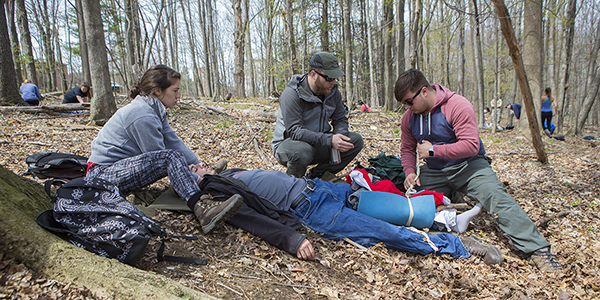Get class credit for going outside with Outdoor Pursuits
, 2022-10-14 14:55:25,
Pushing past your comfort zone is one of the best ways to learn a new life skill. So why not take a course that goes beyond the boundaries of a classroom? Through Outdoor Pursuits, Binghamton University students can take credit classes with nature as the classroom, and learn wilderness skills while fulfilling General Education requirements.
There’s a wide range of options for all kinds of learners. For those wanting to immerse themselves in Binghamton’s natural landscape, hiking instructor Elias Miller teaches students safe, sustainable hiking practices that encourage students to build a relationship with the natural world around them.
“I enjoy taking students into the woods, especially those who don’t have experience hiking, and watching them react to things outdoors that I might take for granted,” he said. “I hope students will develop a long-term interest in hiking and continue to hike after the course ends.”
To Miller, being a good hiker is much more than being able to climb the highest mountains. It extends beyond the physical body: his students develop a knowledge of the wilderness and practice mindfulness to achieve greater harmony with the environment.
“I think hiking benefits students in terms of managing mental health. We practice the Japanese concept of forest bathing, which means spending time meditating in nature,” he said. “My students use this time to focus on things in nature that are different from their daily lives, and it gets them to live presently.”
While hiking and forest bathing is great for developing general physical and mental health, some students might prefer to develop a specific, practical skill set. For them, Backcountry Medicine teaches basic wilderness first aid, and helps students become safer and smarter in the outdoors. Instructor Kevin Hastings favors hands-on lessons over theoretical learning.
“I emphasize a learning-by-doing approach. If my students choose to spend time outside, I want them to be able to handle an emergency and feel well-prepared in any situation,” he said.
Hastings’ students learn about the forest and how to utilize the natural resources to help someone in trouble. They craft splints from sticks, learn how to move injured patients and develop a greater awareness of natural dynamics in the process.
“We’re out in the woods the entire session, doing hands-on care. We role-play scenarios where students play the role of the rescuer. They learn to…
,
To read the original article, go to Click here





